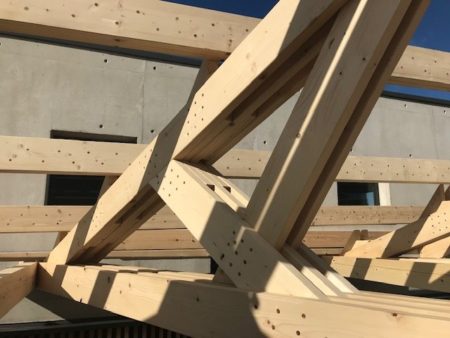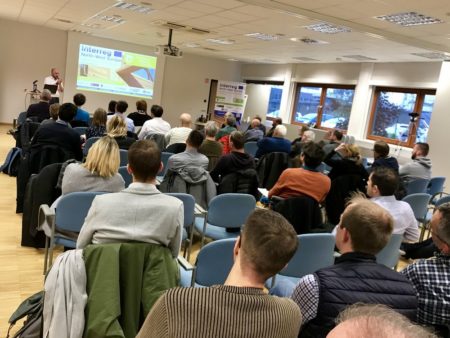 Across Europe, eco-friendly and circular construction is becoming increasingly important.
Across Europe, eco-friendly and circular construction is becoming increasingly important.
In this context, wood, a circular material par excellence, will certainly play a major role in the coming years. It is already being used in many research and innovation projects.
NWE Adhesive Free Timber Buildings is one of such projects. Aimed at addressing the wasteful and harmful use of toxic adhesives in the manufacture of engineered wood products, this Interreg project highlights the “green” alternative to steel and/or concrete.
The ultimate goal is to produce 1 million m3 of such products without adhesives and thus eliminate 6,000 tonnes of toxic adhesives currently used in manufacturing.
This NWE Adhesive Free Timber Buildings (AFTB) project brings together researchers from six prestigious European institutions: the University of Liverpool, the National University of Ireland Galway, the Technical University of Dresden, the University of Lorraine, the Walloon Economic Office for Wood and the LIST in Luxembourg.
 An expanded knowledge base
An expanded knowledge base
On 30 January this year, the Luxembourg Institute of Science and Technology in Belvaux held a presentation of the major results of this programme, which expires in 2020, with good perspectives for the years to come.
Nearly 75 people, mainly active in the wood sector, responded to the invitation. They followed the presentations by Dan Bradley, Project Manager School of Engineering at the University of Liverpool, the organisation that coordinated the project.
He was able to present the progress of research on 100% wood connectors, which make it possible to envisage wood constructions without glue or metals; on trunnion panels to manufacture cross-laminated timber (CLT) without glue; and on densified wood to increase mechanical performance.
Demonstrators were also presented, essential tools for moving from laboratory results to practical application in the field. Dr. Damien Lenoble, Director of the Materials Research and Technology Department at LIST, completed the picture by detailing his activities in wood-related research.
“This event was an opportunity to demonstrate how projects such as AFTB facilitate the development of new technologies and enable the emergence of new sustainable materials, products and manufacturing processes,” says Salim Belouettar, Composites Modelling and Simulation Research Group Leader at LIST, who worked directly on the project. “Our materials specialists have expanded the knowledge base, reduced complexity, accelerated materials and product development and reduced the time from concept to market.”
Bringing together the world of research and business
Specifically, LIST has developed a calculation platform for the modelling and simulation of compressed wood and for the design of adhesive-free engineered wood products. This platform can be used to reduce product development time, to anticipate the effects of re-engineering in a quantitative way and to improve decision making in the early phases of the design process.
“We greatly appreciated this opportunity to focus on this transnational European project,” said François Deneufbourg, Development Manager at the Walloon Economic Office for Wood, who was delighted. “This is a very good way of undoubtedly meeting the requirements of tomorrow’s building regulations and the challenges of the circular economy”.
The University of Lorraine is also delighted with this opportunity to “forge links with the various economic players in order to involve them as early as possible in the overall vision of the AFTB project”, explains Marc Oudjene, Senior Lecturer – University of Lorraine. “This makes it possible to come up with viable technical solutions that include the notions of performance, economic and environmental costs. But it is also necessary to tackle the pre-normative study stage and the regulatory aspects”.
Encouraging and promoting interaction and exchanges between the world of research and companies is one of the primary missions of the Luxembourg Wood Cluster. “This role of federator is an essential aspect of our activity”, confirms Philippe Genot, manager of the cluster, who promoted this research project to companies involved in the Luxembourg ecosystem. “By showing the state of progress of research in Luxembourg in the field of circular construction and wood, we were able to initiate a starting point for imagining a series of future projects around the same topic. This responds, on a daily basis, to an ever-increasing interest on the part of companies that are also looking for new technologies and new developments. The large number of participants at this event reflects this interest.”
